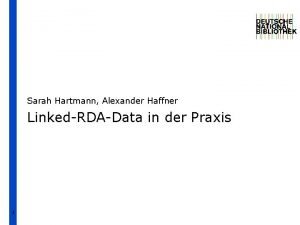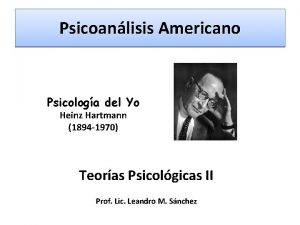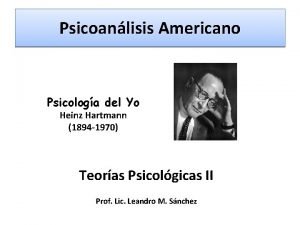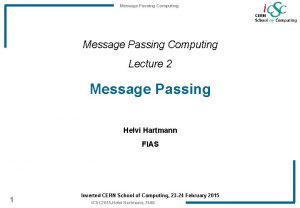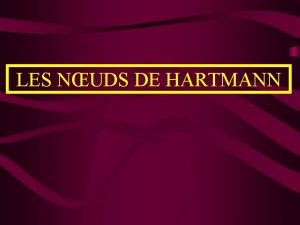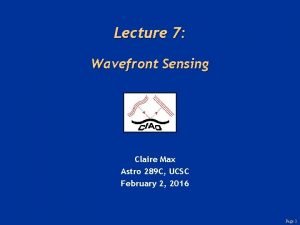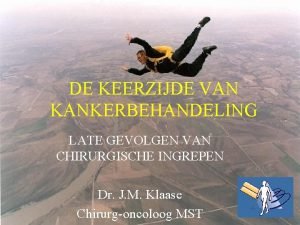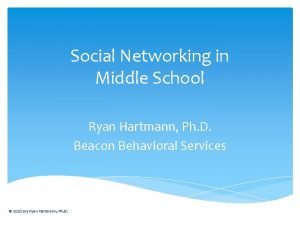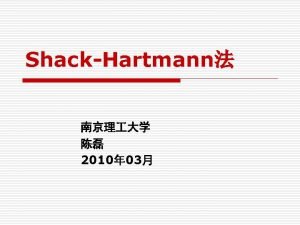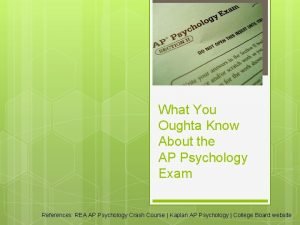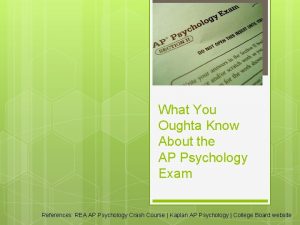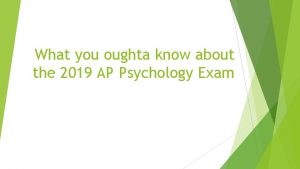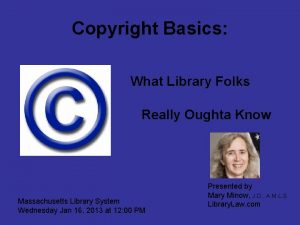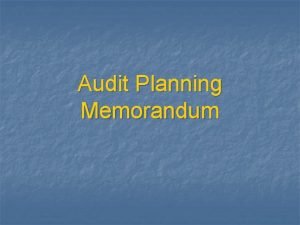You Oughta Audit Terry Hartmann July 11 2009














- Slides: 14

“You Oughta Audit” Terry Hartmann July 11, 2009

Agenda • • What’s an Audit WIIFM How Who When Why Recap

Intro and Disclaimer • Terry Hartmann, CMA, CFM – Certified Management Accountant – Certified Financial Manager • 37+ years experience in Finance • Years of reviews of Dollars For Scholars books • Member, Financial Executives International, past chapter president and current national board member, Audit Committee • NOT a CPA, nor qualified to do Public Accounting or Auditing • Not a member of any auditing firm or association • Takeaway: Experienced advisor, but not an auditor. – Relying solely on my findings and recommendations is not wise; Ignoring them is not smart.

What’s an Audit? • “An official verification of accounts and records, esp. of financial accounts. ” The American College Dictionary • An independent review of the official financial records of an organization by qualified assessors. Range of potential approaches: • • • “Looked OK to me” Annual peer review – same chapter New Treasurer at handoff Peer review – different chapter Professional non-AAUW colleague (source? ) – Independent outside advisor Paid professional audit by outside firm – Review / Assessment – Full audit

Independent Auditor’s Report Pro-Forma To: (addressed to board of directors) We have audited the accompanying balance sheets of X organization as of XXX date (end of fiscal year) 2009 and 2008, and the related statements of income, retained earnings, and cash flows for the years then ended. These financial statements are the responsibility of the organization’s management. Our responsibility is to express an opinion on these financial statements based on our audits. We conducted our audits in accordance with generally accepted auditing standards. Those standards require that we plan and perform the audit to obtain reasonable assurance about whether the financial statements are free of material misstatement. An audit includes examining, on a test basis, evidence supporting the amounts and disclosures in the financial statements. An audit also includes assessing the accounting principles used and significant estimates made by management, as well as evaluating the overall financial statement presentation. We believe that our audits provide a reasonable basis for our opinion. In our opinion, the financial statements referred to above present fairly, in all material respects, the financial position of X organization as of XXX date, 2009 and 2008, and the results of its operations and its cash flows for the years then ended in conformity with generally accepted accounting principles. Signature: Date:

Audit Committee Report Fairport Dollars for Scholars To: (President) From: Audit Committee Objectives: 1 - Review the 2008 Chapter Financial Report’s accuracy and consistency with generally accepted practices; 2 - Verify that the prior year’s audit recommendation(s) has been satisfactorily completed; 3 - Identify other potential issues for Treasurer / Board consideration. Prior year follow-up: (comments on completion of recommendations) Current year opinion: The Chapter Financial Report, dated XX, 2009, satisfactorily reflects the financial position as of (end of fiscal year audited), following directions issued by the national organization (Scholarship America), as confirmed by the audit committee. The records were complete with all documentation readily available. Expenditures were accurate and supported by appropriate documentation. Bank statements examined provided confirmation of (organization) assets. 2008 Findings and Recommendations: ______ Additional comments: Respectfully submitted on behalf of the Audit Committee.

Findings and Recommendations Examples • • • Annual submission form (defined by the national organization to which the DFS chapter belongs) now contains several elements that are beyond the scope of the Treasurer’s duties and should be reviewed by the entire board. Practices which protect the identity of the scholarship recipients should be formally implemented. Segregation of duties practices, e. g. potential scholarship winner’s parent is not eligible to participate in the selection of scholarship winners, should be formally recognized with board policy and direction. Outside insurance provided to directors and officers should be reviewed for currency with latest laws and expectations. IRS form 990 is now required by all not-for-profit organizations, at least in electronic, “e-postcard” form, even if gross receipts/ disbursements are under $25, 000. Cash-based accounting is required by the national organization, yielding different results and different practices than would be expected of an accrualbased business.

Key Themes • Segregation of Duties, independence of participants – Separate, distinct roles must be held by treasurer, president, full board. • Overall Fiduciary responsibilities held by the entire board • Board is anxious to learn and change as needed • Written policies are powerful, but not always easy to develop / implement. – Bylaws and Working Rules are essential • Ignorance is much more likely to cause issues than malevolence

WI I FM (What’s in it for me? ) • Hard work gathering all the relevant documents for periodic review by financial people who need to be educated on how things are done in this chapter… (Treasurer) • Annual focus and closure of the prior year’s results. • Sense of confidence / peace of mind that we’ve had an educated, independent look at the results. • “Trust is not an internal control” • Reinforcement / affirmation of the high quality dedicated efforts by the treasurer. • Suggestions on potential changes to strengthen the organization. • “Bragging rights” at the next convention. • Free Advice – or at least a minimal cost depending on size / approach.

How – Potential Checklist • Decide on the overall approach – resolve with your organization leadership – Paid, external auditor, OR – Local, Regional options as outlined, with goal of independence and professionalism • Enlist “volunteers” or contact outside firm • Plan the event – It takes three hours to assess the local DFS chapter with about 150 disbursements per year and one main bank relationship; three people plus the Treasurer on a Saturday morning. Follow-up and written report requires another two hours. Presentation and discussion at subsequent board meeting is another hour. More serious issues, firsttime, etc. will extend this timeline.

How – what will be examined • • Books and records necessary to validate the financial position reported by the organization for the period under review. Cash Disbursements Consistent with policy in signers and authorization Proper accounts assigned Valid receipts verifying disbursement for reimbursing members Checks cashed timely and consistent with payees; bank records match organization’s books – No cash outlay or very minimal with appropriate documentation. – – • Cash Receipts – Bank records match organization records – Incoming checks payable to recording organization – Incoming checks restrictively endorsed and promptly deposited • • • Balance Sheet – bank records match for amounts and timing Comparison to Budget --- key variances from board-authorized annual budget understood. Any other issues or questions discussed.

Who • Local outside auditing firms will generally have a “non-profit” practice. Ask around – who among your members is a CPA or can provide auditor recommendations. Get a couple of references who match your plans: Size of organization, Scope of audit or assessment, etc. • Non-audit firm approach: – Ask for CPA’s within your organization – either as source of independent outside help recommendation or as less-independent, but still knowledgeable assessor. Most likely the response will be a non-CPA recommendation to avoid apparent conflicts of interest or “free services” and associated liabilities. Ask anyway. – Ask financial members of the organization for help or recommendation. – Ask local chapters of related national organizations: Financial Executives International, Institute of Management Accountants, NYS Society of CPAs, Women in Finance, Chamber of Commerce, National Association of Women Business Owners – Brainstorm other ideas / sources with the chapter

When & Why • When? – Annually after the fiscal year results are finalized. • Before submission of annual report to National / State – At the “Changing of the Guard”, i. e. when new Treasurer or President takes over – Quarterly? Depends on size and complexity of the organization. • Why? – See “what’s in it for me”

Recap • Audit of financial results is recommended – Peace of mind and professionalism • Best to get outside, professional help – If large/complex operation = highly recommended – Failing that – get outside “amateur” help • Not that hard to do – hardest may be to take the first step. • You Really Oughta Audit
 July 30 2009 nasa
July 30 2009 nasa Sarah hartmann berlin
Sarah hartmann berlin Hartmann psicologia
Hartmann psicologia Heinz hartmann biografia
Heinz hartmann biografia Hartmann
Hartmann Hartmann
Hartmann Hartmann von aue
Hartmann von aue Bilder einer ausstellung viktor hartmann
Bilder einer ausstellung viktor hartmann Comment détecter un noeud de hartmann
Comment détecter un noeud de hartmann Shack hartmann wavefront sensor tutorial
Shack hartmann wavefront sensor tutorial Hello song peter weatherall
Hello song peter weatherall Florence hartmann ebu
Florence hartmann ebu Liesklierdissectie
Liesklierdissectie Ryan hartmann
Ryan hartmann Gnomus hartmann
Gnomus hartmann

